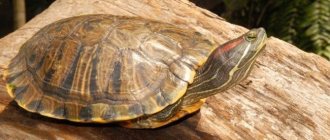At the beginning of July 2021, my wife and I went on vacation to the Lazarevskoye microdistrict, on the coast of the Krasnodar Territory. One fine sunny day, passing by one of the markets, we saw red-eared turtles being sold. In a box with a volume of approximately 5 liters, half filled with water (by the end of the day there was about 10% water left in the box), an indefinite number of animals sat on top of each other, but quite dense for this container. Moreover, they looked like they were about to gasp at once and give up their souls to the Lord. In order to prevent the death of the population inhabiting this box (it simply became a pity), an emergency decision was made to purchase one or two turtles. Next, we approached the “seller” and the following dialogue ensued:
How much does a turtle cost? After looking us up and down and using the rest of his brain for a bit, the “seller” named the price. I don’t remember the prices, since we found out the price, not with the goal of asking the price, but with the goal of understanding which bill to take out of the wallet.
What are the living conditions for the animals? There was no answer to this question. Having explained the essence in the most simple, understandable sentences and gestures, they heard back.
- Well, why is everything fine there? You put her on the floor and she runs for an hour, two, three. Yes, it won’t grow big, you change the water once a month, and in general it’s a very good turtle. And buy two, they will be friends, they will generally feel very good. And he needs to be fed bloodworms, he eats very well.
Realizing that his level of knowledge in keeping turtles was the same as mine in nuclear physics, we simply paid for “2 pieces,” a carrier and some food.
Later there was a two-day trip home, which the animals endured quite well.
In general, the initial lack of comprehensive information about the feeding and maintenance conditions of red-eared turtles leads to the fact that their survival rate tends to zero. That is why I want to share with you, dear readers, the real experience of the content.
How to care for a red-eared turtle at home
Meet this turtle of ours, unfortunately, it doesn’t have a name or a passport, that’s why we call it that – a turtle.
I'll start with the financial part. The costs of maintenance, feeding and care consist of one-time costs and permanent ones. One-time costs include:
- Buying turtles;
- Buying an aquaterrarium, sometimes simply called a turtle aquarium;
- Buying a heater;
- Purchasing a filter;
- Purchasing lighting;
- Buying decorations or toys.
Variable costs include food costs.
How much money was spent on these things? I'll tell you more about everything later.
| What did you buy? | How much |
| Two turtles | 600 rub. |
| Aquaterrarium 1 – 50 liters | 1500 rub. |
| Aquaterrarium 2 – 200 liters | 5000 rub. |
| Terrarium heater 1 | 1500 rub. |
| Terrarium heater 2 | 1800 rub. |
| Aquarium cabinet 2 | 8000 rub. |
| Lighting | 3000 rub. |
| Meals per year (approx.) | 5000 rub. |
| Filters: | 5000 rub. |
| Total: | 30800 rub. |
| It was possible to get by: | 22300 rub. |
And now a couple of tips for the future. The field Could have been done means:
- It was necessary to immediately buy a large aquarium and a powerful heater. At that time, no one told us about this, we were afraid that they would be cramped in a large turtle (you noticed at the beginning I wrote about two turtles), so it is better to buy a large terrarium right away.
- One UV lamp broke very quickly, as did one filter - don’t buy cheap ones - they usually have a two-week warranty, and they break down immediately after the end of the warranty period.
- Nightstands cost between 5,000 and 6,000 rubles, so you can buy them cheaper.
Aquarium for red-eared turtle
After purchasing the turtles, I read a lot of useless information on the Internet about the home of red-eared turtles, I quote, “It should be quite long, but at the same time not wide and low.” Unclear! Start over.
Let's figure out an aquarium or terrarium.
Aqua (lat. aqua) - water.
Terra (from Latin terra) - earth.
In our case, not land, but a piece of land, better known as an island. Therefore, it is correct to call turtle housing in this case an aquaterrarium.
As I wrote above, it is better to immediately buy a large, 200 liter aquaterrarium. The cost of such a home varies depending on the region, manufacturer, and other factors.
The aquaterrarium consists of a piece of land on which the turtle is dried, and the water itself. 200 liters is the total volume, the volume of water takes up about half - the water must cover half of the bridge to land so that the turtle can crawl out, that is, the real volume of water is a little more than 100 liters. Before purchasing an aquaterrarium you must:
- Find out in stores or private craftsmen the standard sizes of two-hundred-liter (but if funds do not allow, then at least 100-liter) aquaterrariums;
- Decide on the place where the red-eared turtle will live. If you have space, you need to measure it and when purchasing from private craftsmen or a custom store, the size of the aquaterrarium can be adjusted - it doesn’t matter to the manufacturers. If you order a cabinet, keep in mind that it will contain not only an aquaterrarium, but also a surge protector that powers the light bulbs, heating and filter. Or think about how to place the food differently.
- Don't forget the backing! 100 liters of water exert a decent pressure (I won’t go into details) on the glass, and it is from this material that aquaterrariums are made, and if a small grain of sand, a setting, or anything gets under the bottom, the bottom can crack, and you know how it can turn around. The substrate smooths out these nuances. I have a backing 2 cm thick.
The aquaterrarium must be cleaned at least once a month, possibly more often; we’ll talk more about cleaning in the section on filters.
The turtle climbed onto the bank to warm up
That’s all, actually, sometimes people ask me how to make an aquaterrarium for a red-eared turtle with your own hands, I answer - I don’t know, and I don’t recommend doing it if you don’t work with glass, and if you do, you know, they’re not small.
Water temperature for red-eared slider
Again, I read on the Internet, people write what, it seems that they are written by people who not only have not kept red-eared turtles, but have never even seen them.
I believe that the optimal temperature for keeping a red-eared turtle is 24-28 degrees Celsius.
Quote:
The red-eared turtle is widespread. Its range covers the United States from southern Virginia to northern Florida and Kansas, Oklahoma and New Mexico in the west, Mexico, all of Central America, northwestern South America (northern Colombia and Venezuela).
The species is introduced to the south of Florida, Arizona, Guadeloupe, Israel, some European countries (in particular, Spain, Great Britain) and South Africa. It has penetrated into Australia, where it is officially recognized as a pest, displacing the local endemic reptofauna.
After analyzing the climate of the habitats, I took the average temperature, for me it is 27 degrees and the turtle feels great. But it is worth considering that the temperature in the aquaterrarium depends on many factors. For example, if the room temperature is near zero, then temperature changes in the aquaterrarium will occur more often; accordingly, the real average temperature will be less than that set on the heater, so I give you the average values.
As for heaters, we use AQUAEL (POLAND), a relatively inexpensive and fairly high-quality heater that has been working stably for a little over a year. The power of the heater depends on the volume of the aquarium. Approximate values of 1 W per 1 liter, this is the minimum. Please note, as I wrote above, that the water in a 200 liter aquarium will be slightly more than 100 liters, so 150-180 W is quite enough, but more is possible.
Reproduction
Turtles reach sexual maturity in nature at 6-8 years of age. In captivity, they grow faster, and sexual maturity occurs earlier: in males by four years, in females by six years.
Preparation for the mating season begins in winter. For turtles, the lighting time is reduced to 6 hours and the water temperature is lowered by 2-3 degrees. This is enough for the turtle to think that winter has come, but not to fall asleep.
In February, the temperature is gradually increased and daylight hours are increased to 10-12 hours. At the same time, turtles believe that spring has come and the time has come for mating games and courtship. For successful reproduction, turtles are fed with vitamins.
Turtles of different sexes are placed in the same aquarium and their behavior is monitored. When the male begins mating games, the female either responds to them or shows aggression. In case of aggression, you should place the turtles for a few days and then try again. If mating is successful, you need to prepare a place for laying eggs.
The turtle requires a piece of land with soil (for example, a container with sand), where it digs a hole, lays 5-20 eggs and carefully buries it. Next, the clutch can be fenced off in an aquarium or the eggs can be removed and placed in an incubator. The incubation time of eggs depends on the ambient temperature.
At a temperature of about 30 degrees, the turtles will hatch in 60 days; if the temperature is lower, the incubation period can increase to 150 days. Newly hatched turtles should be kept separate from others. Turtles lack maternal instinct and can injure babies.
Caring for and maintaining turtles is not a very difficult task. Under good conditions, they can mate and lay eggs up to 5 times a year. With proper care, a red-eared turtle can live up to 40 years and delight its owner with its impressive size.
Filter for red-eared turtle
Regarding filters, I’ll say one thing right away - don’t buy Chinese ones, Chinese filters are not only not of good quality, they’re simply not good.
I use an AQUAEL submersible filter, a good company, and the products are not cheap, but very high quality. For a filter, it is not so much the power that is important, but rather the productivity, measured in liters per hour. And also the volume - the more, the better. For an aquarium with a volume of 200 liters, we (and I think the turtle too) are quite happy with a filter with a capacity of 500 l/h and a volume of 2 liters.
If you have an aquarium of a different volume, contact the sales consultants at the store where you will purchase the filter.
Regarding the period of cleaning the aquaterrarium. I clean once a month, but this is a rather arbitrary period. In fact, you need to keep track of how long it takes for the turtle to become dirty (and the water cloudy), since here again there are many factors involved. This is mainly the size of the turtle and the amount of uneaten food leftovers.
Pros of an animal
Advantages:
- an unpredictable regime can start it . Pets are not too demanding to care for; there is no need to constantly look after them.
- It is easy to create conditions close to natural ones. The turtle feels comfortable in the adapted territory.
- The reptile is easy to take with you on a long trip (on a train, by car). For this, a special carrier or a regular box is used. In addition, the animal can be given to friends for a while (it does not require close supervision).
- Low cost of feed.
- Pets eat food completely (high purity of eating).
- The animal cannot be called aggressive.
- Marine species are brightly colored and highly active.
- Easy to purchase, available in many pet stores.
- Aquatic turtles look after each other.
- Does not cause allergic reactions (especially important for families with small children).
- No street walking is required (one of the most important advantages).
- The feeding frequency for an adult is 2-3 times a week (this is very convenient for the owners).
- The pet is able to live alone; it does not need to acquire an additional friend.
- Does not damage furniture in a house or apartment.
What to feed a red-eared turtle
At the age of up to 1 month, we fed the turtle gammarus; it ate dried better, as it floated on the surface. The turtle did not eat meat, fish, etc., because it was initially accustomed to eating what floats on the surface. Initially, gammarus is a “light” food, but later the food needs to be changed.
What is Gammarus?
Quote:
“Gammarus (lat. Gammarus) is a genus of higher crayfish of the gammarid family of the amphipod order. Includes more than 200 species"
“The analysis shows that 12.8% of the dry weight of gammarus contains 56.2% protein, 5.8% fat, and 3.2% carbohydrates.”
I, of course, did not conduct an analysis and am inclined to believe Wikipedia, but you must agree that for a growing organism, a month-old turtle will not be enough.
We decided to switch to food, since we simply didn’t want to bother with fish, meat, and so on. If you have extra time, then in principle you can try, but believe me, preparing a variety of food for animals, even turtles, takes a lot of time.
After reading reviews and consulting with sellers in pet stores, we decided to feed SERA RAFFY P. It is profitable to buy food not in cans, but in bulk, it is 30% cheaper. A kilogram of feed by weight will cost you about 1,000 rubles. A kilogram package lasts us 2 months. The turtle is growing normally and feels great.
The amount of feed needs to be determined individually, by eye, after which we remember the approximate amount of feed. I want to point out that there are no specific dosages here. A turtle's appetite depends on many conditions of detention, so there are no universal measures here.
By eye this means that we took certain dosages and watched how much the turtle ate without leaving a trace; this dosage was the base dosage for 4 months, since during this time the turtle grew, the dosage increased.
Food for red-eared turtles SERA RAFFY P
Red-eared slider bites
The red-eared slider still bites. And she does this for one simple reason - fear caused by uncertainty. She, just like us, is afraid, and thinks, where are they taking me? Although, with daily training, a red-eared turtle can be trained to handle hands, and it will not bite. But this, again, is time. Red-eared turtles have a pink mouth and pink tongue complemented by rather sharp dental plates. They do not have teeth as such, and the plates are monolithic. And if you are bitten by a one-year-old red ear, be prepared for it to chop off a small piece of your finger. Moreover, keep in mind that a turtle can fully extend its neck to bite, so do not grab it by the shell close to the head.
Diseases of red-eared turtles
If you follow all the recommendations described in the article, the turtle is unlikely to get sick, unless it was sick when purchased.
I am not an expert in turtle diseases, but one thing I can say for sure is that you should not self-treat a turtle at home. For one simple reason - diagnosing the disease on your own is practically impossible, and you can only make it worse.
Look for doctors in veterinary clinics who specialize (or have had at least some practice) in treating red-eared turtles.
Do not read what is written on the Internet, with the exception of forums, since 90% of the articles are written by people who have not held a red-eared turtle in their hands.
Peculiarities of reptile behavior before and after oviposition
It can hardly be said that red-eared turtles are good parents. Males tend to “disappear” immediately after mating. That is, they lose all interest in the recent object of desire, not to mention future offspring. Moreover, even females after laying eggs do not demonstrate any maternal instincts. Moreover, this applies to all types of reptiles, including even the giant iguana.
In other words, the little turtles, which are born two to three months after laying eggs, are left to their own devices. From this time on, they are ready to eat and can lead a lifestyle that will allow them to survive in new conditions.
As for females, after laying eggs they must be temporarily kept separate from other animals. The fact is that their immunity is significantly weakened. Contact with other animals can cause infection with various diseases. Be sure to provide such a turtle with increased nutrition. It should be balanced and rich in healthy vitamins and microelements.
Adults will not take care of small offspring in any way. Accordingly, under no circumstances should they all be placed in one terrarium, since large turtles can harm small ones. We need to wait until they grow up. Although keeping a large colony of red-eared turtles in one terrarium is also not a good solution. So if you are going to breed it, it is preferable for subsequent sale.











